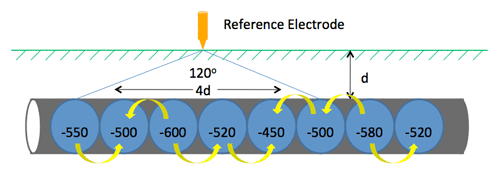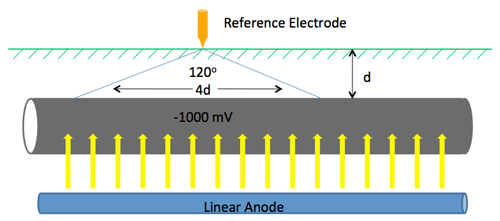የዘይት እና ጋዝኢንዱስትሪ የአለም አቀፍ የኃይል አቅርቦት አስፈላጊ አካል ነው, ነገር ግን በአካባቢው ላይ ከፍተኛ ተጽዕኖ ከሚያሳድሩ ኢንዱስትሪዎች አንዱ ነው. በአካባቢው ላይ የሚደርሰውን ተፅእኖ ለመቀነስ እና የሀብት አጠቃቀምን በዘላቂነት ለማረጋገጥ ኢንዱስትሪው የተለያዩ እርምጃዎችን የወሰደ ሲሆን ከነዚህም አንዱ የካቶዲክ ጥበቃ ቴክኖሎጂን ተግባራዊ ማድረግ ነው። የካቶዲክ ጥበቃ ቴክኖሎጂ የአገልግሎት ዘመናቸውን ለማራዘም እና በዝገት ምክንያት የሚፈጠረውን የፍሳሽ ስጋትን ለመቀነስ በዘይት እና በጋዝ ቧንቧዎች፣ በማከማቻ ታንኮች፣ በባህር ዳርቻ መድረኮች እና ሌሎች ተቋማት በስፋት ጥቅም ላይ ይውላል።
የካቶዲክ ጥበቃ (ሲፒ) ኤሌክትሮ ነው-በኤሌክትሮላይት አካባቢ ውስጥ የብረት አወቃቀሮችን ዝገት ለመከላከል ጥቅም ላይ የሚውል የኬሚካል መከላከያ ዘዴ. ይህ ቴክኖሎጂ የኤሌክትሪክ ፍሰትን በብረት ወለል ላይ በመተግበር በፋሲሊቲዎች ውስጥ ያለውን የዝገት ሂደት ይቀንሳል ወይም ያቆማል። ሁለት ዋና ዋና የካቶዲክ ጥበቃ ዓይነቶች አሉ-የመስዋዕት አኖድ ጥበቃ እና የአሁኑ የካቶዲክ ጥበቃ
የቧንቧ መስመሮች ካቶዲክ ጥበቃ
የቧንቧ መስመር ያለ ሲፒ ተግባራዊ

CP በቧንቧ ላይ ተተግብሯል

1. የመሥዋዕት አኖድ ጥበቃ፡-
በዚህ ዘዴ, ከተጠበቀው ብረት (እንደ ማግኒዥየም, ዚንክ ወይም አልሙኒየም, ወዘተ) የበለጠ ምላሽ የሚሰጥ ብረት እንደ አኖድ ጥቅም ላይ ይውላል. አኖድ ከተጠበቀው ብረት ጋር ሲገናኝ እና ለኤሌክትሮላይት (እንደ አፈር ወይም ውሃ ያሉ) ሲጋለጥ, አኖድው በተሻለ ሁኔታ ይበሰብሳል, ስለዚህ ዋናውን የብረት መዋቅር ይከላከላል.
ጥቅሞቹ፡-
● በአንፃራዊነት ዝቅተኛ የመጀመሪያ ኢንቨስትመንት እና የስራ ማስኬጃ ወጪዎች
● ድንገተኛ ኬሚካላዊ ምላሽ, የጥገና ውስብስብነት እና ወጪዎችን ይቀንሳል
● ምንም ጎጂ ተረፈ ምርቶች፣ በአካባቢው ላይ ያለው ተጽእኖ አነስተኛ ነው።
● በተጠበቀው ብረት ላይ በቀጥታ ተስተካክሏል, ለመጫን ቀላል
ጉዳቶች፡-
● የረጅም ጊዜ የጥገና ወጪዎችን በመጨመር መደበኛ ምርመራ እና መተካት ይጠይቃል
● ትላልቅ ወይም ውስብስብ መዋቅሮችን ሙሉ በሙሉ ላያጠቃልለው ይችላል።
● የዝገት ምርቶች የብረታ ብረት ባህሪያትን ሊነኩ ይችላሉ።
● ከፍተኛ የመቋቋም ችሎታ ባለው ውሃ ውስጥ በደንብ ላይሰራ ይችላል።
2. የተደነቀ የአሁኑ የካቶዲክ ጥበቃ፡
የተደነቀ የአሁኑ የካቶዲክ ጥበቃ የብረታ ብረት ዝገትን ለመከላከል በተለምዶ ጥቅም ላይ የሚውል ቴክኖሎጂ ነው ፣ በተለይም በባህር ምህንድስና ፣ በፔትሮኬሚካልs, የውሃ ህክምና, ወዘተ ይህ ዘዴ የብረት አሠራሩን ከአሉታዊው ጋር በማገናኘት የኤሌክትሪክ ፍሰት ለማቅረብ የውጭውን የኃይል ምንጭ መጠቀምን ያካትታል.ምሰሶየኃይል ምንጭ, ማገናኘትለአዎንታዊው ረዳት አኖድምሰሶ, እናየአሁኑ ፍሰቶችከአኖድወደ የተጠበቀው መዋቅር.
ጥቅሞቹ፡-
● ከፍተኛ ማስተካከያችሎታ, ከተለያዩ አካባቢዎች እና ቁሳቁሶች ጋር መላመድ ይችላል
● አነስተኛ የጥገና ወጪ እና ረጅም የአገልግሎት ሕይወት
● ሰፊ መላመድ፣ ለተለያዩ የውሃ ጥራቶች እና አካባቢዎች ተስማሚ
● የርቀት ክትትል፣ ለማስተዳደር እና ለማስተካከል ቀላል
ጉዳቶች፡-
● ትልቅ የመነሻ ኢንቨስትመንት፣ ያስፈልጋልingሙያዊ መሳሪያዎች እና ቴክኖሎጂ
● በአቅራቢያ ባሉ የብረት መዋቅሮች ውስጥ ጣልቃ ሊገባ ይችላል
● መደበኛ የጥገና ቁጥጥር ያስፈልጋል
● ተገቢ ያልሆነ ቀዶ ጥገና በአካባቢው ላይ ተጽእኖ ሊያሳድር ይችላል
በነዳጅ እና በጋዝ ኢንዱስትሪ ውስጥ የካቶዲክ ጥበቃ ስርዓቶች ዲዛይን, ተከላ እና ጥገና በጣም አስፈላጊ ናቸው. ትክክለኛው የካቶዲክ ጥበቃ የመሳሪያውን የአገልግሎት ዘመን በከፍተኛ ሁኔታ ማራዘም, የጥገና ወጪዎችን መቀነስ እና ደህንነትን እና የአካባቢ ጥበቃን ማረጋገጥ ይችላል.
ቀን፡- ጁላይ 26 ቀን 2024 ዓ.ም





 中文
中文